Agafia Polynchuk
You’ve been creating mixed media dolls for over 25 years. How did you first get into this art form, and what has kept you inspired throughout the years?
As a child, I explored different activities, such as synchronized swimming, singing in a choir, participating in a theater studio, and even joining a hiking club. However, what drew me the most was creating things with my hands. Drawing and ceramics did interest me, but they didn’t captivate me like making soft toys.
When I was 10, I attended my first soft toy-making class, and that passion has stayed with me for life. At first, I worked with ready-made patterns provided by my teacher, but over time, I felt the need to create something of my own, something unique. As I grew older, I started experimenting with materials, designing my own patterns, and adding new elements to my work.
The skills and experience I accumulated made possible the dolls I create today. Why haven’t I lost interest in this craft after so many years? I believe it’s because these dolls have become my way of self-expression. It’s more than just a hobby or a job — it’s who I am, and I can’t imagine doing anything else.
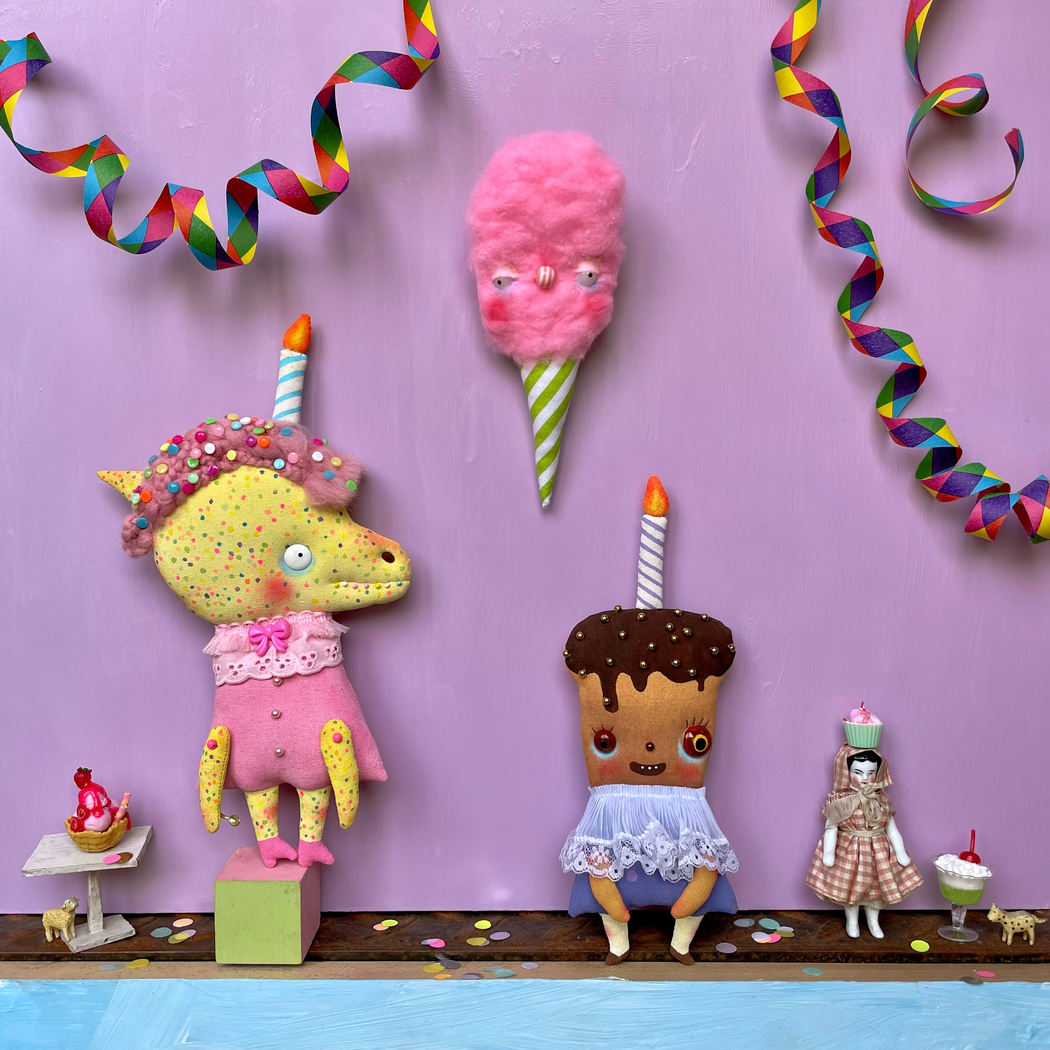 Agafia Polynchuk | Swizzles Sprinkleycorn & Wishy Flicker
Agafia Polynchuk | Swizzles Sprinkleycorn & Wishy Flicker
Your work explores complex themes such as psychological defense mechanisms and existential needs. How do you approach such profound concepts through the medium of dolls?
My dolls, whether they represent a person, an animal, or even an inanimate object, reflect human essence and the psycho-emotional state in general. In a way, they serve as allegories, similar to how animals are used in fables to convey ideas and feelings. The doll becomes a mold for many emotions, including fears, pain, joy, memories, and hope, illuminating different aspects of human nature.
When exploring psychological defense mechanisms, I often present them as “masks”. Through the doll, I investigate how people accept or deny reality, how they endure and simply survive, or, conversely, rebel to change their lives for the better. For me, a doll is a means to look inside a person and express what is sometimes difficult or impossible to articulate in words.
Non-ideality, asymmetry, and altered proportions all emphasize the desire to be heard and understood — a desire that resides deeply within each of us.
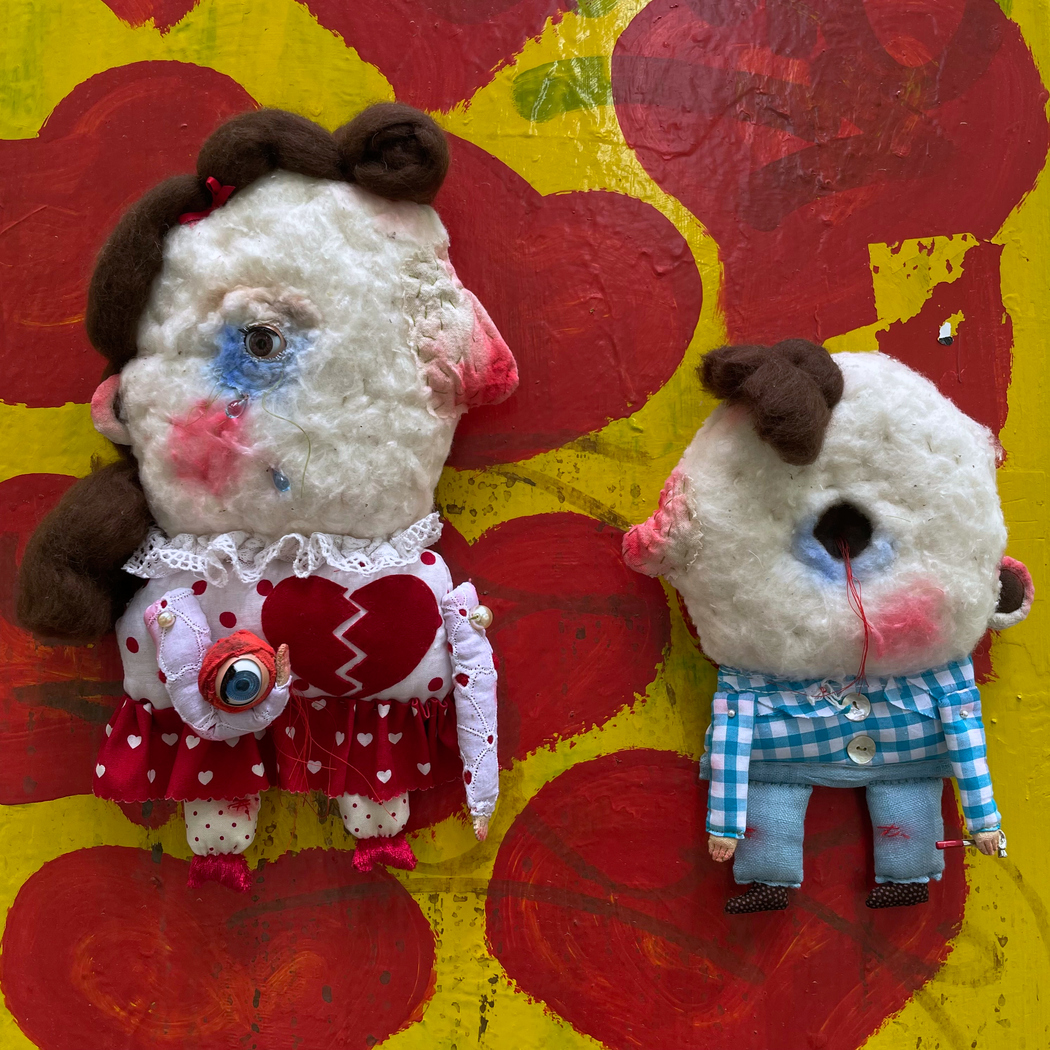 Agafia Polynchuk | Lovers
Agafia Polynchuk | Lovers
You use deconstruction and collaging of meanings as your main methods. Can you explain how these techniques manifest in your dolls and the stories they tell?
When I speak of deconstruction, I refer to a process where I take an object apart, analyzing its structure and elements. From each part, I take something — such as texture, color, or shape — and then reassemble it according to my own vision and format. In this process, absurdity, irony, and black humor become my main methods and principles for assembling images and stories. They also act as psychological defense mechanisms, allowing me to detach from reality and view it from a different perspective.
For example, the Swizzles Sprinkleycorn unicorn doll embodies the joy and festive atmosphere inspired by the Birthday Confetti Cake. Birthdays are always magical, just like the unicorn itself, which symbolizes dreams and childhood. I took the cake’s colors: the rainbow sprinkles are represented by bright dots on the doll’s body, and the pink hair and shoes resemble frosting. The unicorn horn acts as a candle, ready to fulfill a wish, while the golden spoon in her hand hints at dessert. It’s as though she’s prepared to taste herself, waiting with curiosity and trepidation for what comes next.
In addition, I often combine elements from different eras and times. For instance, I may merge modern synthetic fabrics with antique beads or vintage accessories. This juxtaposition of past and present creates a new story — one that is not always obvious, but deep and layered.
My dolls are not merely decorative objects; they invite dialogue. I aim to create more than just an object. I want everyone who looks at my work to see something of their own, to ask questions, to reflect, and perhaps to gain a deeper understanding of themselves.
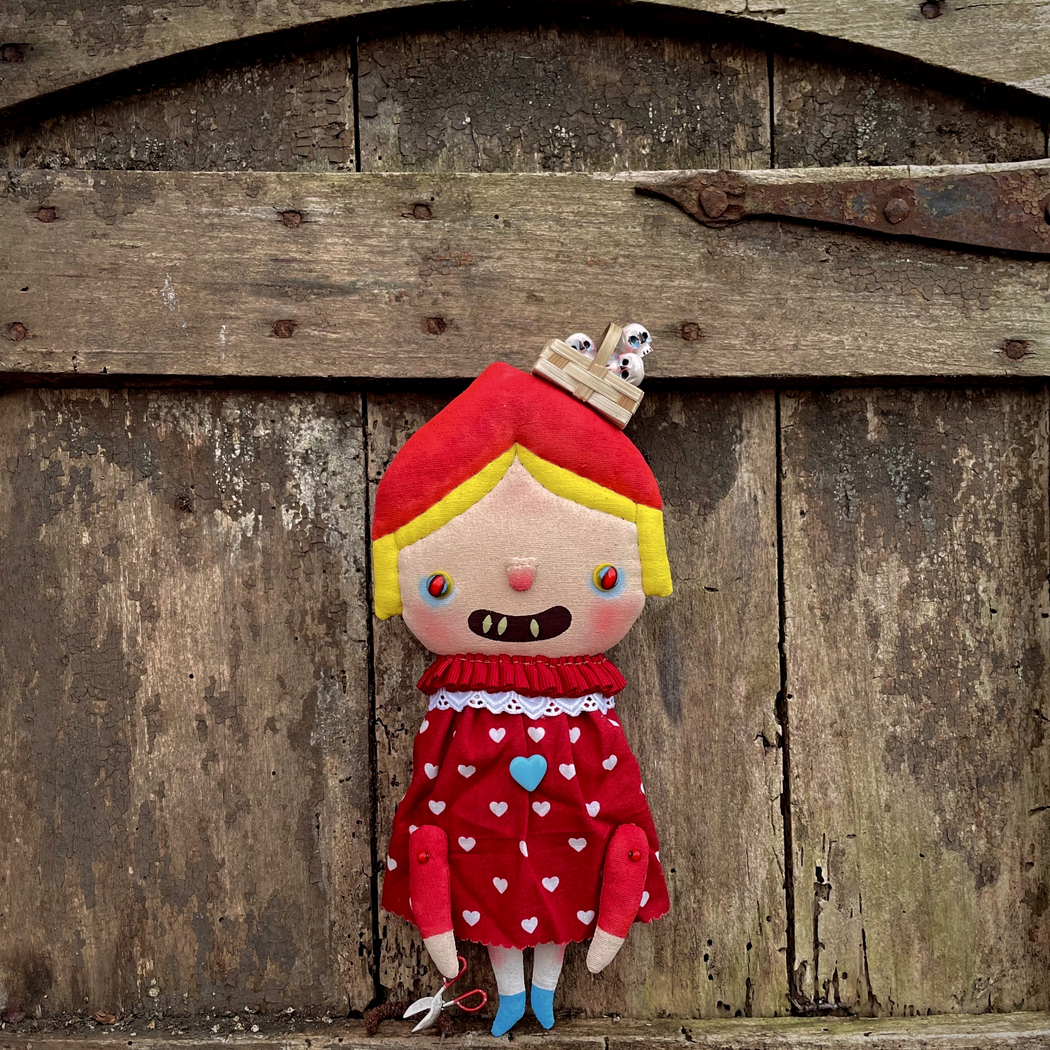 Agafia Polynchuk | Red Biting Hood
Agafia Polynchuk | Red Biting Hood
What is the significance of the grotesque and absurd in your work, and how do these elements help convey the themes you explore?
The grotesque and absurd help convey the complex psychological states and inner conflicts of my characters. These elements allow me to distort, exaggerate, or reduce reality, enabling me to transcend conventional logic and reveal the absurdity of life — both comical and tragic. The grotesque heightens tension or distracts the viewer, making not all details immediately apparent. Exaggerated proportions can highlight a character’s inner state while maintaining an element of surprise. Through this absurdity, I explore existential questions about how people confront chaos and navigate the balance between tragedy and comedy in everyday life, reflecting the contradictions and absurdities of our world.
For example, look at my dolls “Lovers”. They explore the metaphorical and literal concept of “exchanging eyes”, drawing on the Victorian tradition of lovers exchanging portraits of each other’s eyes. With a limited color palette and vintage elements, it highlights the complexities and traumas of love, capturing the essence of companionship through grotesque distortions of form on a Berlin alley bench, a symbolic space for lovers to meet and part.
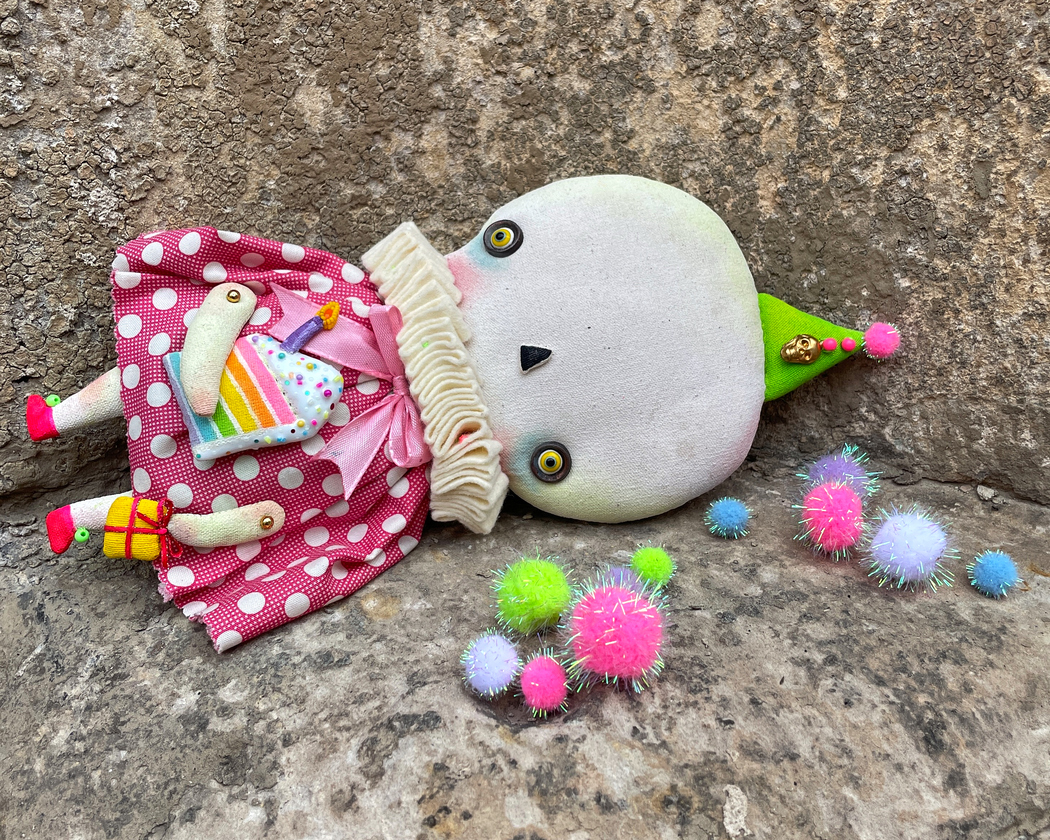 Agafia Polynchuk | Boneeta Tartypop
Agafia Polynchuk | Boneeta Tartypop
Many of your dolls draw inspiration from German fairy tales, traveling circus aesthetics, and folklore. How do these cultural elements shape your artistic vision?
German fairy tales have their own unique features: they are filled with mythology, didactic elements, a special understanding of good and evil through symbolism, and an ominous atmosphere. I would say they shape my artistic perception. I appreciate their dark, disturbing side, which is especially evident in Grimm’s fairy tales, such as Frau Trude (where the witch turns a curious girl into a log and throws her into the fire) and “On the death of a chicken” (where everyone dies in the end), as well as in my favorite, Red Riding Hood. There is a harsh reality in them, as life can sometimes present events that feel like nightmares — dangerous, unpredictable, and even life-threatening.
I enjoy playing with the themes of good and evil, and by mixing characters, I create new, unexpected realities. For example, in my interpretation, Little Red Riding Hood might wear a wolf coat or be his wife. These explorations of traditional images allow me to search through deeper themes related to human nature and our struggle with the outside world.
My birthday falls on Halloween, which likely influences my inclination to play with the themes of fear and festivity. I love atmospheres that blend horror and joy, reflected in the traveling circus aesthetic that brings celebration, theatricality, absurdity, and fantasy into my work. This circus aesthetic allows for various metamorphoses, paradoxes, and transformations, yet there is always an underlying hint of sadness and melancholy.
My dolls exist on the boundary between fictional worlds, fantasy, and harsh reality. They blend joy with sadness and celebration with drama, reflecting the complex emotions and layered symbols found in fairy tales and folklore.
Your dolls are not just visual objects but are often staged theatrically. How important is storytelling in your work, and how do you use it to evoke emotional responses in your audience?
I believe that narrative plays a crucial role in my work. Each doll is not merely a decorative object but a complete character with its own story. When creating a doll, I consider not just its appearance but also its character, dreams, fears, and past and present. This is reflected in the details I choose, such as fabrics, accessories, textures (buttons, vintage brooches, dollhouse items, lace, etc.). Every detail is significant and carries symbolic meaning; even a small change can transform a doll into an entirely different character with a unique story. It is important to me that each doll tells its own story and evokes emotions in the viewer.
Recently, I have been reinforcing the images of my dolls by giving them speaking names and accompanying them with short texts that serve as a starting point for perception. These texts are written by a friend of mine and help the viewer to enter the world of the character and to understand their story more deeply.
Staged photographs of my dolls extend the narrative they convey. These images aren’t just a way to document or preserve the doll’s appearance; they are an opportunity to create an immersive atmosphere. By carefully crafting the scene, I can add layers of emotional depth and enhance the character’s portrayal, supporting their story and helping to reveal their inner world.
Photography allows me to highlight the mood of my dolls and visually express what can be difficult to articulate. It serves as a window into their world, enabling viewers to either discover new dimensions of the character or confirm an image already formed in their minds. By placing my dolls in real-world settings, I create an interaction between the imaginary and reality, deepening the connection between the character and the viewer. Each photo becomes a story in itself, full of meaning and personal interpretation.
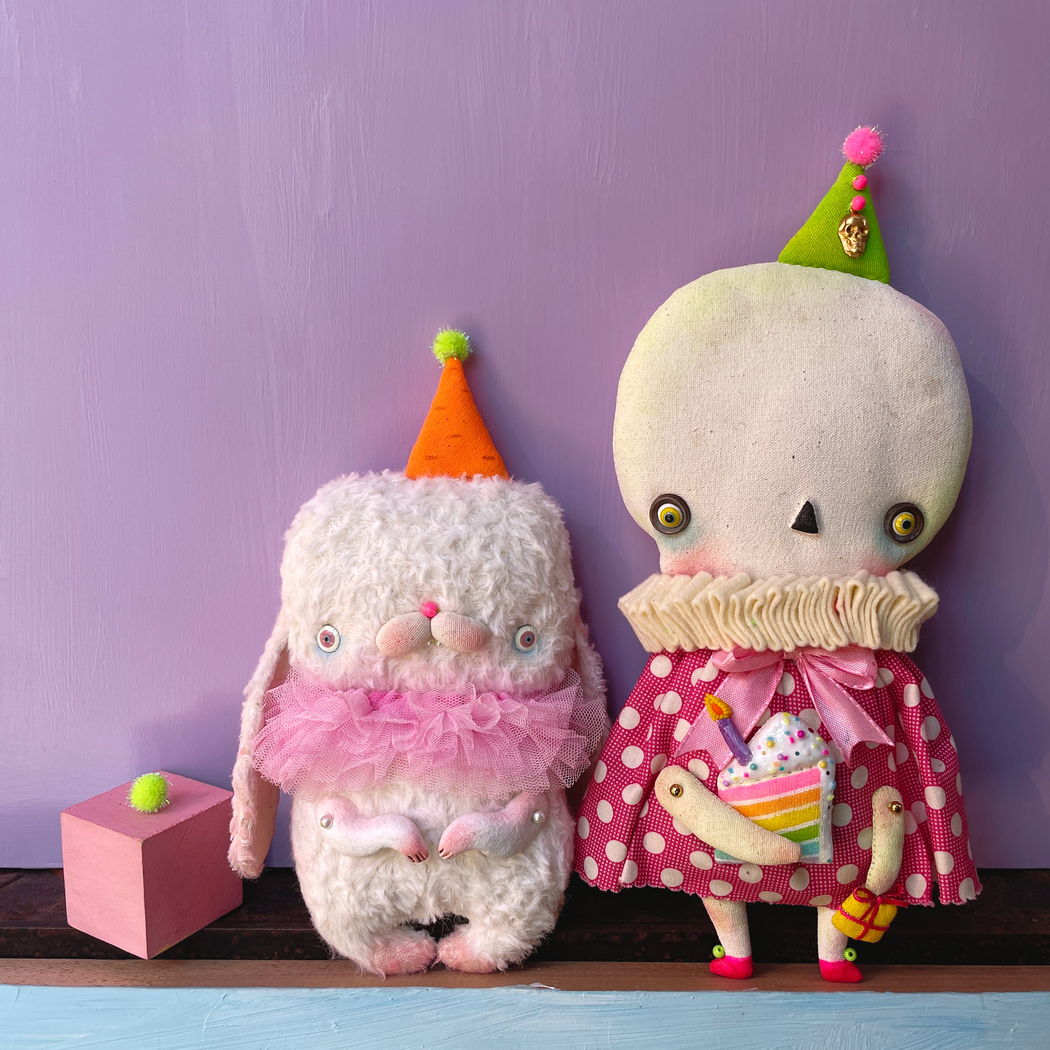
You mention using materials like cotton, vintage accessories, and elements of your own photographs. How do these materials contribute to the narrative or emotional depth of your dolls?
For the base of my dolls, I use unbleached calico, which is a strong, dense cotton fabric that for me is like a blank canvas for a painter or a white sheet for a writer. From it I create shapes, which I then dye in the colors I want. This allows me to not depend on factory fabrics with their predetermined colors and textures, which gives me the freedom to create my own world. After dyeing, the dolls become even more rigid, which adds a certain coldness and detachment to them. This helps me convey the feeling I strive to put into my work. I often use cotton fabric for dolls’ clothing, which reminds me of the time when I was a kid. Its colors and patterns evoke a sense of nostalgia that I try to convey through my characters.
Vintage accessories found at flea markets give my dolls a sense of time and history. These details make them more realistic and authentic, and also help ‘transform’ the dolls into people. This duality allows the viewer to see the dolls not just as objects, but as individuals with their own destinies. Each detail adds a new page to the character’s story. As a result, the viewer is confronted with a reflection of human experience and emotions, which makes the interaction with the dolls even more meaningful. It is as if these pieces tell the story of a life that the dolls have already lived. They carry a note of nostalgia, like heirlooms passed down, something special and sacred.
As for photographs, I integrate them into my dolls through techniques such as cyanotype on fabric or using Polaroid shots to create details. This allows me to add a personal element to my characters, to bring in a part of my own story, which makes the doll more mysterious and deeper in terms of narrative.

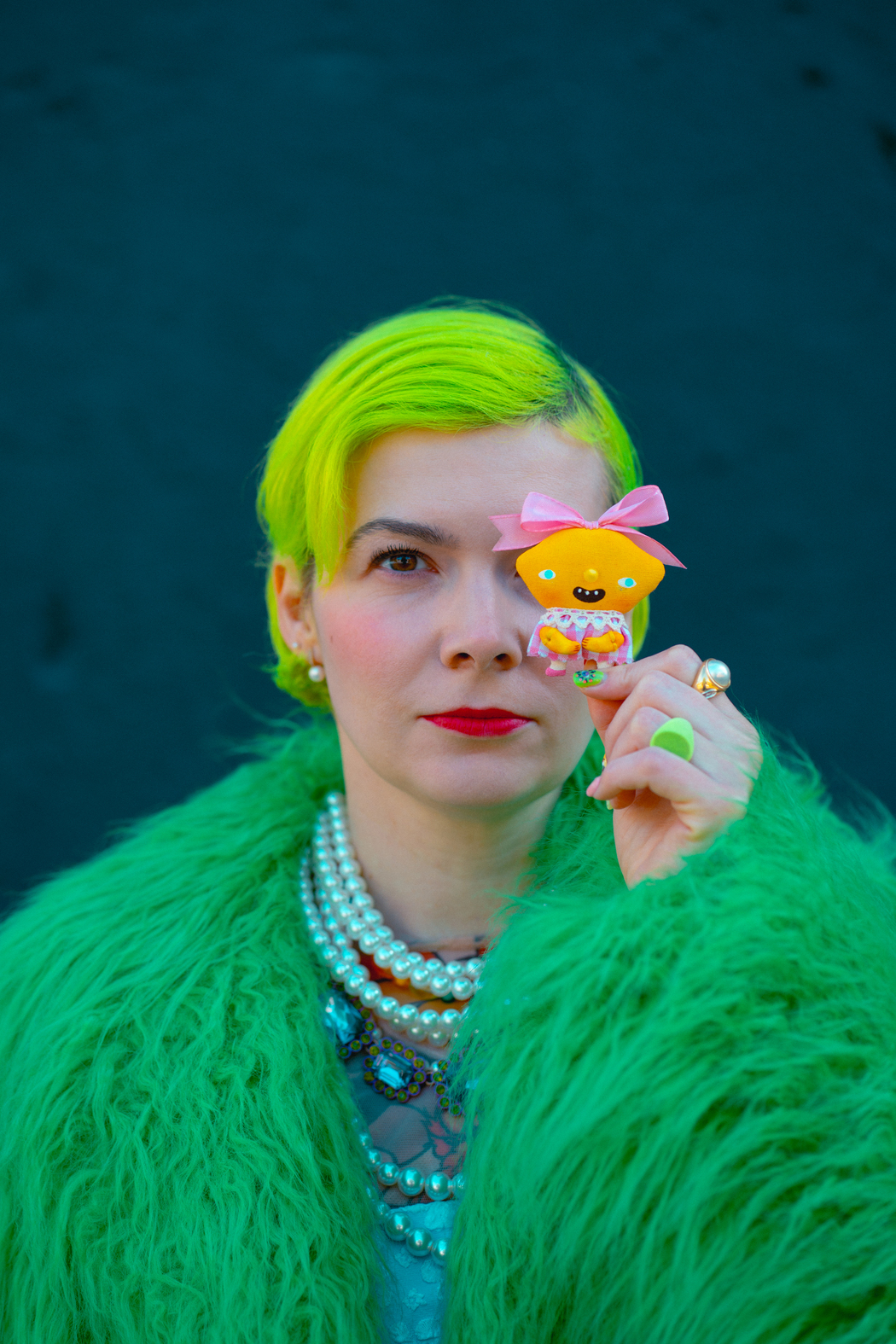
Leave a Reply